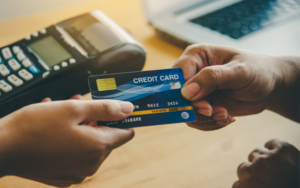 You may have seen “0% interest” or “0% APR” used to advertise a whole host of different financial products and repayment schemes. It essentially means that borrowing money is free, at least for a set period of time. With a standard credit card, you could avoid having to pay any interest by clearing the balance by the end of the billing period. With 0% interest credit cards, you have until the end of the offer period to clear the balance to avoid paying any interest. However, there are plenty of pitfalls that could leave you with a hefty bill. In this article we will explain what a 0% credit card is, how it works and how to use one effectively.
You may have seen “0% interest” or “0% APR” used to advertise a whole host of different financial products and repayment schemes. It essentially means that borrowing money is free, at least for a set period of time. With a standard credit card, you could avoid having to pay any interest by clearing the balance by the end of the billing period. With 0% interest credit cards, you have until the end of the offer period to clear the balance to avoid paying any interest. However, there are plenty of pitfalls that could leave you with a hefty bill. In this article we will explain what a 0% credit card is, how it works and how to use one effectively.
What does 0% APR mean?
APR stands for annual percentage rate and is the total cost of borrowing for a year. It is expressed as a percentage, so 5% APR on a £10,000 loan will cost £500 a year. APR includes interest on the money you owe, as well as mandatory charges, such as an annual fee on a credit card.
If an APR is 0, it means that you will not need to pay interest or fees to borrow money in that year.
How do 0% credit cards work?
0% APR credit cards do not charge interest on the balance of your card for a set period. How long the 0% interest lasts for will depends on the exact card you have, but the most common duration is between one and three years. This can help you to spread the cost of an expensive purchase, consolidate debt or access free credit in an emergency. Whatever you purchase with the card will cost you exactly what you originally spent, without any extra interest, so long as you clear the balance before the end of the 0% period.
What happens after the 0% offer period ends?
Your credit card will continue to work and you can carry on making purchases with it, but you will need to pay interest on your outstanding balance. If you can always clear the balance in full at the end of every billing period, you can continue to use the card without paying interest. However, if you do not fully repay what you owe, you could be hit with surprisingly high interest charges.
Credit cards with 0% interest can often turn into high-interest credit cards at the end of the initial offer term. This means that you should plan to pay off the balance before the term expires.
Keep in mind that some card providers will end the 0% period early if you miss a minimum repayment.
What are the different types of 0% interest credit cards?
There are many different types of credit cards, which you can read about in our article ‘Credit card types explained: What are the different types of credit cards?’. When it comes to 0% interest credit cards, there are two main types to focus on, balance-transfer credit cards and purchase credit cards.
What does 0% on balance transfers mean?
A 0% APR balance-transfer credit card allows you to move your existing credit card debt over to a card with an interest-free introductory period. This can save a significant amount of money on interest and help you focus on repaying what you owe. You will need to budget to clear the debt by the end of the 0% interest period to avoid moving onto a much higher rate. You should also budget for a balance transfer fee, which will be a percentage of the amount you move to the new card. Find the best deals on balance transfer cards in our article ‘Best 0% balance transfer credit card deals’.
What does 0% on purchases mean?
A purchase credit card with a 0% interest rate period allows you to spend on the card and repay over the duration of the 0% offer without paying any interest. With a standard credit card, you will start to pay interest on a purchase if you do not clear your credit card balance by the end of the month. With a 0% purchase credit card, the time you have to repay for free is extended over several months or years.
It is important to remember that the 0% interest offer is unlikely to apply to cash withdrawals or foreign transactions, though exactly how much each would cost will depend on your credit card provider.
Go to our ‘Compare the Best 0% purchase credit cards’ article to find the best deals on 0% purchase credit cards.
How to find out which credit card is best for you
Money to the Masses has partnered with Creditec* to help find the best credit card for you. By entering a few basic details, you will be able to see a tailored list of the best credit cards based on your individual circumstances. You can sort your results by the feature that interests you most, such as by card type, total fees or cashback offered. On top of this, the credit cards that have been pre-approved for you will be highlighted, meaning you can be more confident that you will be accepted if you apply. (Pre-approval does not guarantee acceptance and is still subject to additional lender checks). Your details will be used to conduct a soft credit search often referred to as an eligibility check, which means your credit score will not be affected. Click on this link to get started*.
When to use 0% interest credit cards
0% interest credit cards allow you to borrow money for free, if you repay the debt within the offer period. However, they are not a sign of a card provider’s generosity. Enough people will miss payments or still have an outstanding balance at the end of the interest free period to make providing the card profitable for the provider. You can avoid these pitfalls by using your card in the scenarios in which a 0% interest credit card will be most helpful. These include:
Consolidating debt
Not all debt is equal. A high APR can mean that you spend more money on interest payments and fees than you do on repaying the debt. If the money you owe is on a 0% interest credit card, you will not pay any interest if you repay the money before the end of the offer period. If your debt is not on a 0% interest credit card, you may be able to transfer it using a balance transfer credit card. Keep in mind that you will usually have to pay a balance transfer fee, which is a percentage of the amount moved over to the new card.
Even taking into account the balance transfer fee, you can save a considerable amount by moving debt from multiple expensive credit cards to one 0% balance transfer card. It can also make repayments simpler, as you will have one monthly bill rather than many. We have more details in our article 'What is the best way to consolidate my debt?'.
Spreading the cost of big purchases
Using a 0% purchase credit card means you can spread a big spend over the entire length of the offer period. With a standard credit card, you would need to pay for anything you bought that month by the end of the billing period to avoid paying interest. With a 0% purchase credit card, you have until the 0% offer ends. This means you could stretch paying for a big holiday or a new sofa over many months.
You also have added flexibility with a credit card compared to a loan, as you could borrow less or more – depending on your credit limit – if final costs change. We weigh up taking out a loan versus using a credit card in our article ‘Is it better to get a credit card or a personal loan?’.
Emergency cover
Keeping a 0% interest credit card in your wallet as a backup can be a great way to cover any unexpected or emergency costs. If you suddenly need to buy a new car tire, rebook your holiday or pay a big vet bill, a 0% credit card can allow you to turn a large one-off cost into smaller monthly instalments. You will not need to pay interest on the money if you are able to repay it within the 0% period.
If you plan to use your 0% interest credit card for emergencies, make sure you have a high enough limit to cover the costs. You can also benefit from section 75 protections when using a credit card. This ensures you can get a refund if something goes wrong with a purchase between £100 and £30,000. Read our article ‘Section 75 of the Consumer Credit Act explained – plus how to claim’ for more information.
How to choose a 0% credit card
There are two key components to a good 0% interest credit card – the length of the interest-free period and what the rate will climb to once that period ends.
The longer the interest-free period, the longer you will have to clear the balance of the card before you need to start paying interest. This will give you more flexibility and make it easier to pay off the debt in equal monthly repayments.
Even though you should always plan to clear the balance on your 0% interest credit card before the rate goes up, it is a good idea to consider what the rate would be should you fail to pay the money back as quickly as you had hoped. Some card providers will hike the interest rate considerably once the interest-free period ends, while others will introduce a more reasonable increase. You could also consider a balance transfer credit card once your 0% credit card starts charging interest.
Pros and cons of a 0% credit card
It is important to understand the basic advantages and disadvantages of a 0% interest credit card before you apply.
Pros of a 0% credit card
- Avoid paying interest for a set period of time
- Spread the cost of a purchase over the 0% period
Cons of a 0% credit card
- The 0% interest rate only lasts for a limited period of time
- Missing a repayment can cause the interest rate to shoot up
- The interest rate will rise sharply once the 0% period ends
Who can get a 0% credit card?
0% interest credit cards are usually only available to applicants with excellent credit scores. If you do not have an excellent credit score, you may find that your application is rejected or you are offered a shorter interest-free period. However, there are plenty of ways to improve your credit score. Read our article ‘How to improve your credit score quickly’ to learn more.
If you already have a 0% interest credit card and you are heading towards the end of your interest-free period without clearing your outstanding balance, you should seek out free debt advice as soon as possible. We have more information in our article ‘Where to get free debt advice’.
If a link has an * beside it this means that it is an affiliated link. If you go via the link Money to the Masses may receive a small fee which helps keep Money to the Masses free to use. But as you can clearly see this has in no way influenced this independent and balanced review of the product.







